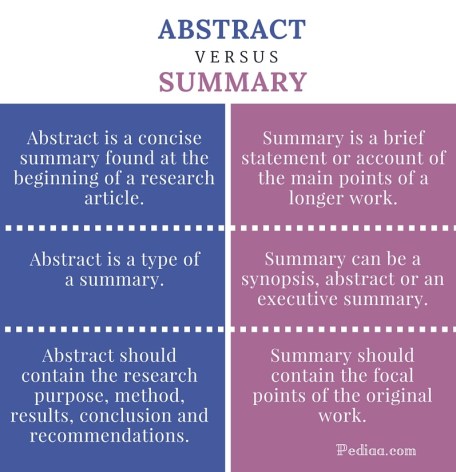Main Difference – Abstract vs Summary (アブストラクトとサマリーの違い)
アブストラクトとサマリーという2つの用語は同じ意味で使われることが多いですが、アブストラクトとサマリーの間には明確な違いがあります。
要約は、長い著作物の凝縮版です。
アブストラクトは、研究記事や論文などの冒頭に記載される簡単な要約のことです。
これがアブストラクトとサマリーの大きな違いです。
アブストラクトは要約の一種です。
アブストラクトとは
アブストラクトとは、より大きな著作物を要約した、短くも力強い文章または説明のことです。
研究論文、卒業論文、学位論文などの簡単な要約です。
アブストラクトは通常、文書の冒頭に置かれ、文書全体の紹介やレビューとして機能します。
作品の背景、目的、結果、内容に関する情報が含まれることもあります。
アブストラクトには通常、研究の焦点、研究方法、結果、主な結論、推奨事項の4つの要素が含まれます。
抄録は、独立した存在として機能することができます。
多くの組織では、研究を選択する際の基準としてアブストラクトを使用しています。
また、オンラインで入手できる研究論文のほとんどはアブストラクトの形式をとっており、読者はアブストラクトを読んでその論文を購入するかどうか判断することができます。
このように、抄録は、読者が時間やお金をかけて論文全体を読むべきかどうかを判断するのに役立つと言える。
There are basically two types of abstracts: descriptive abstracts and informative abstracts. Descriptive abstract or limited abstracts simply provide a description of the content of the abstract (purpose, method, scope). Informative abstracts also contain the description of the content, but it also contains the results, conclusions and the recommendations of the author.
サマリーとは
要約とは、文章の中心点を含む簡潔な文章または説明のことである。
テキストの凝縮版または要約版と定義することができる。
中心的で最も重要な概念のみが含まれているため、原文よりもかなり短くなります。
要約という言葉は、いくつかのことを指すことがあります。
要約とは、本、記事、映画、演劇などのあらすじを指すことがあります。
ここでは、プロットのアウトラインをサマリーと呼ぶことができます。
ビジネスレポートや企画書、プランの冒頭に見られるエグゼクティブサマリーもサマリーであり、内容全体を要約し、文書の中心点を強調するものです。
また、研究論文で使われるアブストラクトも同様のサマリーです。
When you are writing a summary of a given text or documents, you should always use your words; a brief quote can be sometimes used. Since the main purpose of this type of summary is condensing the text, it should contain the main ideas and concepts of the original text clearly and concisely. Your opinions and criticism of the original text should not be written in the summary. In addition, it shouldn’t contain things like examples, details or any unnecessary information.
アブストラクトとサマリーの違い
定義
抄録とは、研究論文の冒頭に記載される簡潔な要約のことである。
また、「要約」とは、長い著作物の要点を簡潔に述べたものです。
インターコネクション
Abstractは要約の一種です。
要約はシノプシス、アブストラクト、エグゼクティブサマリーのいずれにもなりうる。
内容
研究目的、方法、結果、結論、提言を記載する。
Summary should contain the focal points of the original work.
